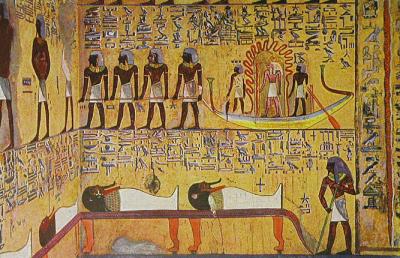2010: The year of Egyptian Archaeology
French journalist recently asked me: "What were the major archaeological discoveries of 2010?" I answered that all the major archaeological discoveries of 2010 were made in Egypt, by experienced and professional Egyptian archaeologists, and that we could safely say that 2010 was the year of Egyptian archaeologists. As for what was the most important archaeological discovery of 2010, there can be no doubt that this is the revelations surrounding the tomb of King Seti I.
Mystery has long surrounded the long passageway discovered inside the tomb of King Seti I, and the last person to try and uncover the secrets of this passageway was a man named Sheikh Ali Abdel Rasoul, more than 50 years ago. However after Sheikh Al Abdel Rasoul excavated 130 meters down into this dark passageway, his workman found it increasingly difficult to breath or move due to the accumulation of dust particles and lack of sufficient oxygen, not to mention the piling up of the rubble that they had excavated. As a result of these constraints, Sheikh Ali Abdel Rasoul had a narrow sub-tunnel for himself and his men dug alongside the original passageway. As a result of these difficult conditions, the Supreme Council of Antiquities (SCA) pulled the plug on the excavation efforts, however Sheikh Ali Abdel Rasoul continued to believe that this passageway led to the real tomb of King Seti I, and that his treasures were still buried at the end of this tunnel.
Until now, I still don't know why Sheikh Ali Abdel Rasoul was so committed to this belief, and I met with him a number of times in 1973, and I even accompanied him to the entrance of the tunnel inside the tomb of King Seti I in the Valley of the Kings. Sheikh Ali Abdel Rasoul never explained to me why he was so certain that the treasures of King Seti were inside this tunnel, and archaeologists were unable to even try to dig inside this passageway for fear of causing the tomb to collapse. However the decisive moment came in 2007 when I, along with my team, attempted to unravel the secrets of this mysterious tunnel that began inside the tomb of King Seti I.
We first shored up the passageway with solid interconnected braces to prop up the ceiling, which enabled us to remove the rubble inside the tunnel safely. We also produced a wooden walkway to facilitate the movement of the labourers and the work team inside the tunnel. The rubble was then removed by small carts on fixed metal rails inside the tunnel, these carts were used for ascending or descending the tunnel, which was an extremely difficult and arduous process. The beginning of this tunnel starts in the burial chamber, which itself lies at a depth of more than 90 meters, and we discovered that the tunnels extended for another 170 meters beneath the burial chamber.
The mere realization that the ancient Egyptians had managed to reach such depths was, in itself, a shock. Excavating this wide tunnel required continuous effort on our part, and this lasted for around three years. In the end, we managed to excavate and shore up all the areas that Sheikh Ali Abdel Rasoul and his men previously reached. It appeared that he had diverted from the normal path of the tunnel and begun digging above the body of the original one. This diversion, coupled with the restoration of the original body of the tunnel, cost us a lot of time and effort to correct and carry out.
We discovered 54 stone steps within this tunnel each standing at a length of two meters. We also found a false door decorated with hieratic text hewn into the rock, which read "Move the door jamb up and make the passage wider." This was instructions to the original labourers working inside this tunnel. We then chanced upon another set of 37 steps hewn into the rocks. There was another surprise after this, namely that at a depth of 174.5 meters, the tunnel hit a dead-end. In other words, this was nothing more than an incomplete tunnel.
To clarify, this passageway was a royal tomb hidden within the original [tomb]. To be more precise; the ancient Egyptians had dug and decorated the first 98 meters for the original tomb, then thought of building a new hidden structure by digging an extension to the first part of the tunnel. However due to the fact that King Seti I ruled for only 12 years, the architect was not able to carry on with the new plan for the secondary tomb. This can be seen in the 38th and final stone step which the ancient Egyptian labourers were in the process of finishing, when they must have got the order to abandon their work. However perhaps Ramses II, who is the son of Seti I, succeeded where his father failed, in constructing a hidden secondary passageway and tomb behind his [original] tomb. In any case, this is something that we are going to investigate in 2011.
Asharq Alwasat, 16/01/10
- Συνδεθείτε για να υποβάλετε σχόλια
 Εκτυπώσιμη μορφή
Εκτυπώσιμη μορφή- Send by email

